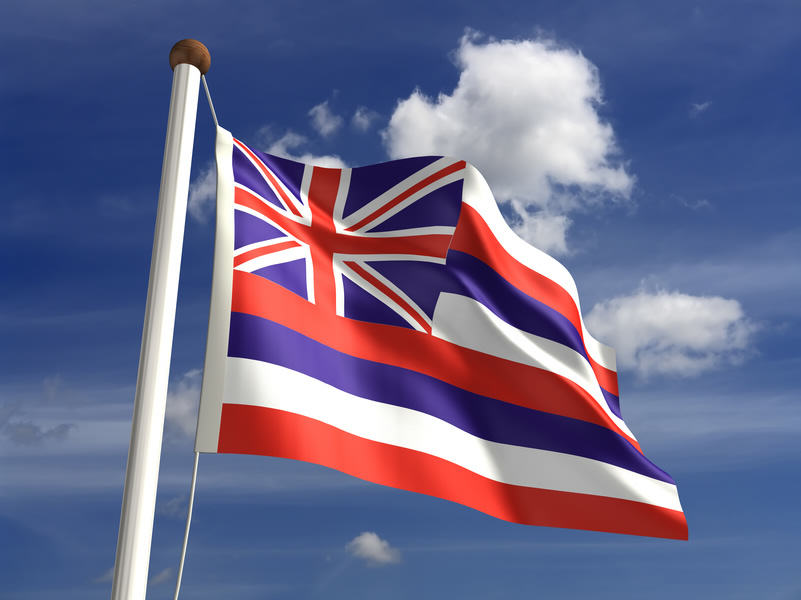The Hawaii flag, also referred to as the Hawaiian flag or Hawaii state flag, has a rich and complex history. It bears the unique distinction of being the only U.S. state flag to feature the Union Jack of the United Kingdom, a historical symbol that sparks curiosity and prompts the question, “Why does Hawaii have a British flag?”
In this comprehensive article, we’ll delve deep into the history of the Hawaiian state flag, answering key questions and shedding light on the flag’s unique design.
Origins of the Hawaii Flag
Believe it or not, the Hawaiian flag predates Hawaii’s statehood by over a century. The flag’s history dates back to the early 19th century during the reign of King Kamehameha I.
Tradition holds that the King commissioned the flag’s creation in 1816. Yet, the details of its inception are murky, steeped in historical ambiguity and folklore. There are several theories about why the Hawaiian flag features elements of both the British and U.S. flags.
One popular theory posits that King Kamehameha I received a Union Jack from British explorer Captain George Vancouver as a symbol of friendship and protection. The King, who admired the British flag, was inspired to incorporate it into the design of the Hawaiian flag.
What Does the Hawaiian Flag Look Like?
The Hawaiian flag stands out for its unique design that blends elements of different cultural influences. It consists of eight horizontal stripes, representing the eight main islands of Hawaii: Hawaii, Maui, Oahu, Kauai, Molokai, Lanai, Niihau, and Kahoolawe.
The color scheme of the stripes, white, red, and blue, reflects the influence of the American flag and represents innocence, valor, and vigilance, respectively.
In the top left corner is the Union Jack, symbolizing Hawaii’s historical relationship with Great Britain. Its inclusion creates a flag of distinct hybrid identity, telling a story of Hawaii’s past as a sovereign kingdom and its strategic alliances.
A Symbol of the Kingdom of Hawaii
Throughout the 19th century, the Hawaiian flag served as a symbol of the Kingdom of Hawaii, fluttering above Iolani Palace and marking the Kingdom’s ships and territories. The flag was also a symbol of resistance during periods of political upheaval.
During a brief period in 1843 known as the Paulet Affair, British officer Lord George Paulet seized control of the Hawaiian Islands, replacing the Hawaiian flag with the Union Jack. Upon the resolution of the dispute, King Kamehameha III raised the Hawaiian flag once again, proclaiming, “Ua Mau ke Ea o ka ‘Aina i ka Pono,” which translates to “The life of the land is perpetuated in righteousness.” This phrase is now the state motto of Hawaii.
From Republic to Territory to State
In 1893, the Hawaiian monarchy was overthrown, leading to the establishment of the Republic of Hawaii. The Hawaii flag continued to serve as the national flag until 1898 when the islands were annexed by the United States and Hawaii became a U.S. territory.
The Hawaiian flag was subsequently adopted as the official flag of the Territory of Hawaii. When Hawaii became the 50th U.S. state in 1959, it was only fitting that the historic Hawaiian flag was adopted as the official Hawaii state flag.
The Significance and History of the Hawaii Flag Today
Today, the Hawaii flag serves as a potent symbol of the Aloha State’s diverse cultural heritage and rich history. It flies on flagpoles throughout the islands, from the State Capitol in Honolulu to the volcanic peaks of the Big Island, a constant reminder of the islands’ unique journey.
So, what is Hawaii’s flag? It’s more than just a piece of fabric; it’s a historical tapestry weaving together the story of a unique Pacific archipelago. Its distinctive design embodies Hawaii’s past as a sovereign nation, its enduring ties with both Great Britain and the United States, and its continuing identity as an integral part of the American family of states.
From answering the question, “why does Hawaii have a British flag?” to understanding the symbolism behind the flag’s design, it’s clear the Hawaii flag holds a deep historical significance. The next time you see the Hawaiian flag fluttering in the tropical breeze, take a moment to appreciate the rich and complex history it represents.

Scott Sweeney is the creator of Virtual Hawaii 360. Scott is a professional marketer and a lifelong Hawaii enthusiast. Scott splits time between Oahu and Dayton, Ohio. In addition to his marketing endevours, he is also a published Ukulele musician.





